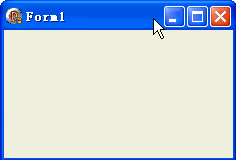function CreateThread(
lpThreadAttributes: Pointer;
dwStackSize: DWORD;
lpStartAddress: TFNThreadStartRoutine;
lpParameter: Pointer; {入口函数的参数}
dwCreationFlags: DWORD;
var lpThreadId: DWORD
): THandle; stdcall;
线程入口函数的参数是个无类型指针(Pointer), 用它可以指定任何数据; 本例是把鼠标点击窗体的坐标传递给线程的入口函数, 每次点击窗体都会创建一个线程.
运行效果图:

代码文件:
unit Unit1;
interface
uses
Windows, Messages, SysUtils, Variants, Classes, Graphics, Controls, Forms,
Dialogs;
type
TForm1 = class(TForm)
procedure FormMouseUp(Sender: TObject; Button: TMouseButton;
Shift: TShiftState; X, Y: Integer);
end;
var
Form1: TForm1;
implementation
{$R *.dfm}
var
pt: TPoint; {这个坐标点将会已指针的方式传递给线程, 它应该是全局的}
function MyThreadFun(p: Pointer): Integer; stdcall;
var
i: Integer;
pt2: TPoint; {因为指针参数给的点随时都在变, 需用线程的局部变量存起来}
begin
pt2 := PPoint(p)^; {转换}
for i := 0 to 1000000 do
begin
with Form1.Canvas do begin
Lock;
TextOut(pt2.X, pt2.Y, IntToStr(i));
Unlock;
end;
end;
Result := 0;
end;
procedure TForm1.FormMouseUp(Sender: TObject; Button: TMouseButton;
Shift: TShiftState; X, Y: Integer);
var
ID: DWORD;
begin
pt := Point(X, Y);
CreateThread(nil, 0, @MyThreadFun, @pt, 0, ID);
{下面这种写法更好理解, 其实不必, 因为 PPoint 会自动转换为 Pointer 的}
//CreateThread(nil, 0, @MyThreadFun, Pointer(@pt), 0, ID);
end;
end.
窗体文件:
object Form1: TForm1 Left = 0 Top = 0 Caption = 'Form1' ClientHeight = 128 ClientWidth = 229 Color = clBtnFace Font.Charset = DEFAULT_CHARSET Font.Color = clWindowText Font.Height = -11 Font.Name = 'Tahoma' Font.Style = [] OldCreateOrder = False OnMouseUp = FormMouseUp PixelsPerInch = 96 TextHeight = 13 end
这个例子还有不严谨的地方: 当一个线程 Lock 窗体的 Canvas 时, 其他线程在等待; 线程在等待时, 其中的计数也还在增加. 这也就是说: 现在并没有去处理线程的同步; 同步是多线程中最重要的课题, 快到了.
另外有个小技巧: 线程函数的参数是个 32 位(4个字节)的指针, 仅就本例来讲, 可以让它的 "高16位" 和 "低16位" 分别携带 X 和 Y; 这样就不需要哪个全局的 pt 变量了.
其实在 Windows 的消息中就是这样传递坐标的, 在 Windows 的消息中一般高字节是 Y、低字节是 X; 咱们这么来吧, 这样还可以使用给消息准备的一些方便的函数.
重写本例代码(当然运行效果和窗体文件都是一样的):
unit Unit1;
interface
uses
Windows, Messages, SysUtils, Variants, Classes, Graphics, Controls, Forms,
Dialogs;
type
TForm1 = class(TForm)
procedure FormMouseUp(Sender: TObject; Button: TMouseButton;
Shift: TShiftState; X, Y: Integer);
end;
var
Form1: TForm1;
implementation
{$R *.dfm}
function MyThreadFun(p: Pointer): Integer; stdcall;
var
i: Integer;
x,y: Word;
begin
x := LoWord(Integer(p));
y := HiWord(Integer(p));
{如果不使用 LoWord、HiWord 函数可以像下面这样: }
//x := Integer(p);
//y := Integer(p) shr 16;
for i := 0 to 1000000 do
begin
with Form1.Canvas do begin
Lock;
TextOut(x, y, IntToStr(i));
Unlock;
end;
end;
Result := 0;
end;
procedure TForm1.FormMouseUp(Sender: TObject; Button: TMouseButton;
Shift: TShiftState; X, Y: Integer);
var
ID: DWORD;
num: Integer;
begin
num := MakeLong(X, Y);
{如果不使用 MekeLong、MakeWParam、MakeLParam、MakeResult 等函数, 可以像下面这样: }
//num := Y shl 16 + X;
CreateThread(nil, 0, @MyThreadFun, Ptr(num), 0, ID);
{上面的 Ptr 是专门将一个数字转换为指针的函数, 当然也可以这样: }
//CreateThread(nil, 0, @MyThreadFun, Pointer(num), 0, ID);
end;
end.


【推荐】编程新体验,更懂你的AI,立即体验豆包MarsCode编程助手
【推荐】凌霞软件回馈社区,博客园 & 1Panel & Halo 联合会员上线
【推荐】抖音旗下AI助手豆包,你的智能百科全书,全免费不限次数
【推荐】轻量又高性能的 SSH 工具 IShell:AI 加持,快人一步